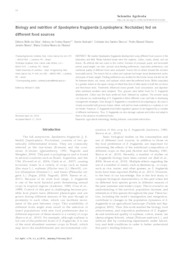Biology and nutrition of Spodoptera frugiperda (Lepidoptera: Noctuidae) fed on different food sources.
Biology and nutrition of Spodoptera frugiperda (Lepidoptera: Noctuidae) fed on different food sources.
Autoria: SILVA, D. M. da; BUENO, A. de F.; ANDRADE, K.; STECCA, C. dos S.; NEVES, P. M. O. J.; OLIVEIRA, M. C. N. de
Resumo: We studied Spodoptera frugiperda development using different food sources in the laboratory and field. Newly hatched larvae were fed soybean, cotton, maize, wheat, and oat leaves. An artificial diet was used as the control. Duration of pre-pupal, pupal, and larva-adult period, pupal weight, sex ratio, survival, larva feeding preferences, oviposition preferences, and nutritional quality of different hosts were evaluated. Insects fed on wheat showed the shortest larva-adult period. The insects fed on cotton and soybean had longer larval development cycles and pupae of lower weight. Feeding preference was evident for third instar larvae and did not differ between wheat, oat, maize, and soybean, which were the preferred hosts. Moths oviposited to a greater extent on the upper canopy of wheat than that of other plants in both the no-choice and free-choice tests. Treatments influenced insect growth, food consumption, and digestion when nutritional variables were analyzed. Thus, grasses were better hosts for S. frugiperda development. Cotton was the least preferred food, followed by soybean. The present study can improve our understanding of S. frugiperda in these different crops and help in developing management strategies. Even though S. frugiperda is considered to be polyphagous, this pest is closely associated with grasses (maize, wheat, oat) and has lower potential as a soybean or cotton feeder. Howerver, S. frugiperda food intake regulation appears to be triggered by a complex of different mechanisms. Thus, S. frugiperda can also damage soybean and cotton and adapt to them in the absence of preferred hosts.
Ano de publicação: 2017
Tipo de publicação: Artigo de periódico
Unidade: Embrapa Soja
Palavras-chave: Crop entomology, Entomologia, Feeding behavior, Lagarta do cartucho
Observações
1 - Por padrão são exibidas publicações dos últimos 20 anos. Para encontrar publicações mais antigas, configure o filtro ano de publicação, colocando o ano a partir do qual você deseja encontrar publicações. O filtro está na coluna da esquerda na busca acima.
2 - Para ler algumas publicações da Embrapa (apenas as que estão em formato ePub), é necessário ter, no celular ou computador, um desses softwares gratuitos. Sistemas Android: Google Play Livros; IOS: iBooks; Windows e Linux: software Calibre.
Acesse outras publicações
Acesse a Base de Dados da Pesquisa Agropecuária (BDPA) para consultar o acervo completo das bibliotecas da Embrapa.

